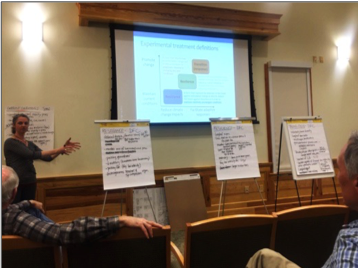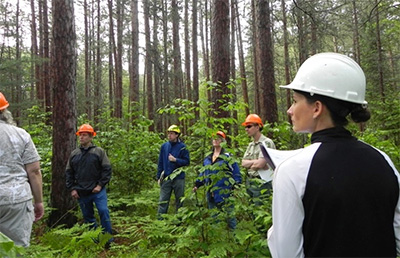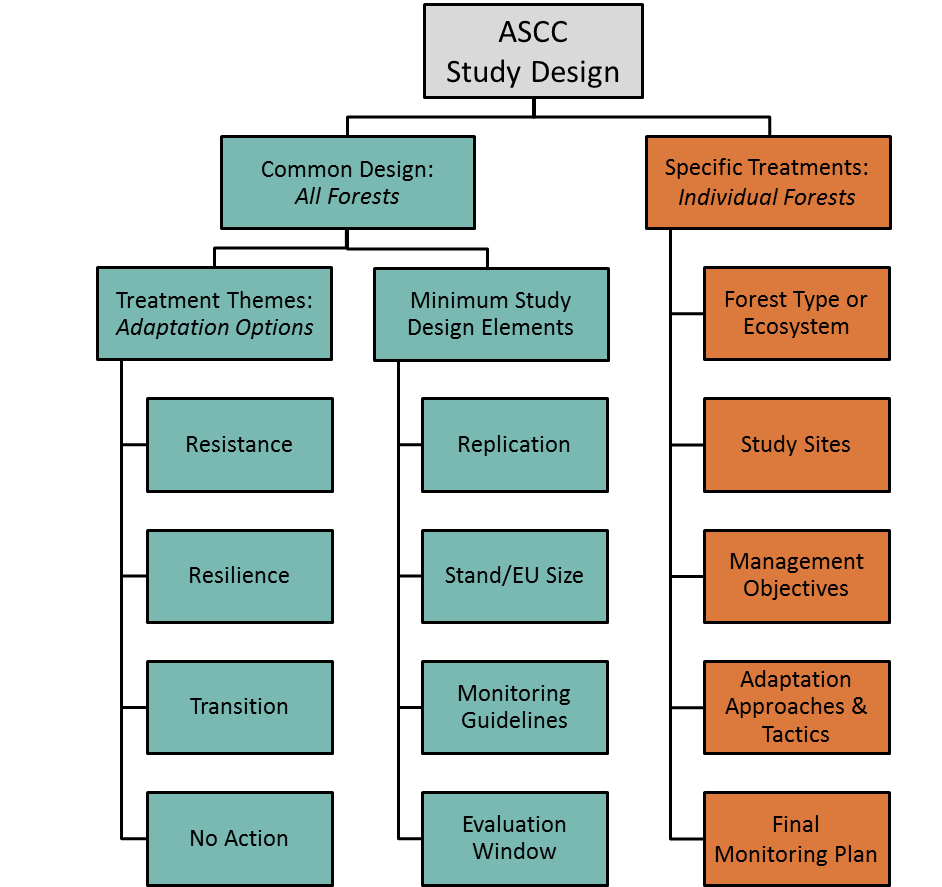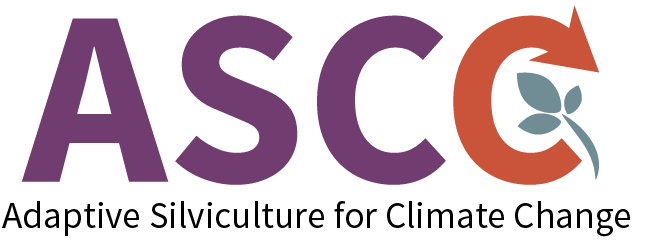The ASCC study is designed to maintain key experimental design elements that are consistent across all study sites while allowing individual sites to tailor treatments to their unique, local contexts. All ASCC sites followed the same co-development process involving both managers and scientists, with each site utilizing the same experimental approach and study design structure for treatment types and spatial/temporal factors.
The Workshop


To kick-start the study at each site, workshops were held to familiarize local managers and scientists with adaptation approaches and tactics for forest management. Each ASCC site utilizes three adaptation options (resistance, resilience, and transition), as well as a control or “no action” treatment where no management takes place. Since climate change is already occurring, no “true” control is possible; thus, the no-action treatment serves as a baseline for how forests without active management respond to the same climatic factors the treatment areas experience.
Prior to each workshop, the ASCC Network leads, site lead scientists, and key managers meet to summarize existing information, identify stakeholders and constituencies for the workshop, and identify speakers and “expert panel” members to participate in designing the experiment. We compile site-level information, including inventory data, relevant forest plan parameters, and fine- and broad-scale contextual information and resource needs, which are utilized during the workshop.
The first day of each workshop typically serves as a stand-alone training for natural resource professionals. Trainings begin with presentations covering climate science basics, climate trends, and a synthesis of impacts and vulnerabilities specific to the region. Participants are then led through several exercises where they identify climate change considerations for silvicultural planning and decision-making in the context of the silvics and disturbance ecology of local forest ecosystems. Participants then split into groups and use elements of the Forest Adaptation Resources Workbook (Swanston et al. 2016) to develop climate change adaptation tactics for a forest type of their choice, which they later present to the larger group. The overarching goals of this training day are to give participants usable tools for incorporating climate change considerations into management planning and give them a chance to practice doing so in a learning environment fostering discussion and reflection.
The second and third days of the workshop consist of an expert panel of 10-20 managers, regional scientists, and the ASCC Network leads, with the goal of designing site-specific desired future conditions (DFCs), identifying management objectives, and developing silvicultural tactics to meet the overarching goals of the resistance, resilience, and transition treatments for the forest type of interest. This portion of the workshop begins with a visit to the prospective field site, with accompanying maps, inventory data, and site-level information in-hand. Specific ecosystem vulnerabilities and climate change impacts are evaluated within the context of stand history, current conditions, and parameters of any local forest planning documents. This discussion informs the development of DFCs, management objectives, and tactics that correspond to each of the experimental treatments, tailored to the specific conditions and climate change concerns of the site.
The third and final day of the workshop includes review and refinement of the DFCs, management objectives, and tactics, as well as the identification of any planning needs, a common measurement plan for pre- and post-treatment data collection, implementation considerations and timeline, roles and responsibilities, and designated next steps.
ASCC Study Design
We developed a set of site-level minimum standards for all ASCC Network sites. All ASCC study sites consist of a minimum of four replicates of the four treatments (resistance, resilience, transition, and no action), with each treatment unit 20-25 acres in size, across a reasonably uniform forest study area. Each ASCC site adheres to a common measurement protocol within a determined evaluation window (short- and long-term) and includes pre-treatment measurements ahead of treatment implementation, allowing for future cross-site comparisons. The common set of core monitoring variables includes overstory, mid-story, and understory forest composition, assessment of forest health, and measures of productivity.
Each ASCC treatment unit is operational in scale to spatially and volumetrically reflect common landscape management operations. The treatments typically entail significant timber harvests at each site, adding to the value and sustainability of the research.
All ASCC study sites monitor overstory, mid-story, and understory forest composition, as well as health and productivity using a consistent data-collection protocol. In order for the ASCC approach to be applicable to any and all forest types, the tactics employed at each site vary. A panel of expert scientists and managers at each ASCC study site determine the particular study areas within their region that are appropriate for treatment, and tailor the specific treatment design elements to local conditions and concerns. Each ASCC experimental unit is measured before and immediately after treatment implementation, and is re-measured at consistent time intervals of three, five and 10 years following treatment.
Key response variables to be collected at each ASCC site:

The ASCC Network is testing these management-related ideas:
- Will adaptation approaches and treatments work in a real-world context to meet local management goals and objectives?
- How feasible are the treatments silviculturally, as well as in terms of financial, social, or other management constraints?
- How does our idea of desired future conditions (DFCs) change with each treatment type?
- What does it mean to deliberately create a future-adapted ecosystem, and why would a manager choose to do this?
- What tradeoffs exist between achievement of adaptation objectives and other common objectives for a given region and ecosystem type?
The scientific questions to be addressed through hypothesis-driven research at each ASCC site include:
- Do the treatments create significant changes to forest conditions over time at a particular site, and how do treatments compare across sites?
- How do hypothesized treatment responses (DFCs) compare with actual responses observed in the future?
- Do these treatments achieve what they were designed for?
- What criteria emerge to enable managers to identify which treatments perform best?
- Does one type of treatment (resistance, resilience, transition, or no action) consistently perform better across all sites?

